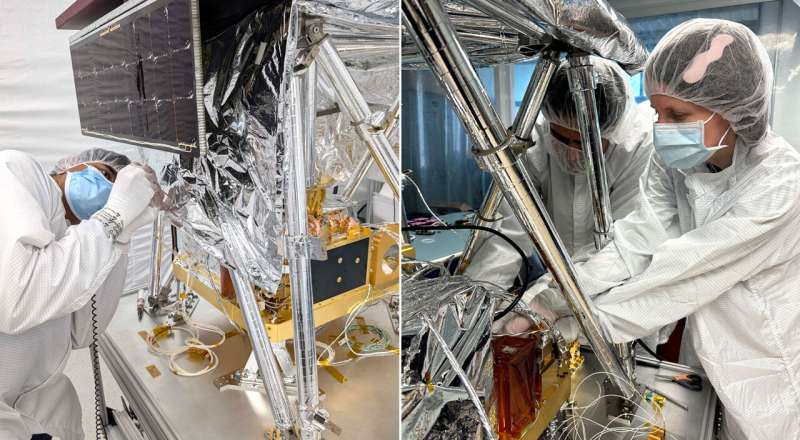We’ve been talking about sending a radio telescope to the far side of the Moon for awhile now. Now that reality is one step closer with the completion of the design and construction phase of the Lunar Surface Electromagnetics Experiment-Night (LuSEE-Night) radio telescope project. This milestone marks a major step in the development of the system, which is planned to launch on a lunar lander in 2026.
Any radio telescope on the far side of the Moon will have plenty of advantages over any radio telescopes within sight of Earth, since the lunar far side is the one place in the solar system that isn’t ever affected by radio noise coming from the Earth itself. That isolation allows it to search for faint signals from the early universe, such as the coveted “Dark Ages” signal that emanates from when the universe was only 380,000 years old, before planets and stars were formed.
Radio interference from Earth typically drowns out the Dark Ages signal, which is why a radio telescope on the far side of the Moon, which is protected from that interference by the Moon’s mass, is so appealing. Unfortunately, that also means any equipment sent there has to contend with the harsh environment on the lunar surface, which includes not only massive amounts of radiation, but massive temperature swings of over 300 C.
Fraser discusses why a far-side lunar telescope would be so useful.
Those temperature swings also happen over the course of weeks, with the 14 days of night dropping the temperature on the far side to -173 C, while during the 14 day lunar day it can get as high as 173 C. That day/night cycle also means that, if the system is using solar panels, it must be able to power itself for at least two weeks without being recharged – which, in practical terms means it has to have a massive battery.
Battery selection was just one part of the component selection and design process that went into this step of the project. Most of the component selections were handled by three different institutions – Lawrence Berkeley National Laboratory, which handled the antenna design and its pointing mechanism, UC Berkeley Space Studies Laboratory, which handled thermal management and also served as the integrator on the project, and Brookhaven National Laboratory, which was responsible for the electronics design as well as the spectrometer, which is the key component in breaking the radio signals into their constituent parts so they can be studied.
As with all projects, there were engineering constraints put into place – with one of the most important being a weight restriction. LuSEE-Night had to weigh no more than 128 kg in order to fit on the Blue Ghost lunar lander it was intended to go to the Moon on. It might not be a huge surprise, but a large chunk of that weight was dedicated to the battery, which itself weighed in at a massive 50 kg. The reality of current battery physics requires one that large two last the entire system through two weeks of no recharging.
Far discusses more generally what’s on the far side of the Moon.
Even with that battery constraint, the rest of the system actually came in under its weight budget, with some of the components, like the power supplies and radio communication equipment, being selectable off the shelf. However, one sub-system that was not just available off the shelf was the thermal management system. UC Berkeley designed a combination heat pip that transfers the heat generated both by solar radiation and by operation of the telescope’s instruments to a radiator which uses radiation to transfer the heat into space. A series of thermal switches helps control the internal temperature of the system as well, turns sub-systems on and off as necessary to ensure thermal stability.
That could be one of the biggest challenges to one of LuSEE-Night’s primary objectives that sets it apart from other potential far-side radio telescopes – it wants to collect data 100% of the time. This involves a complex melding of thermal and power management, and still gives the operators the ability to switch collection operations off at any time.
In fact, collecting Dark Age data is actually the secondary mission for LuSEE-Night – it is primarily meant as a technology demonstration mission to prove that radio telescopes can last on the far side of the Moon, and viably collect data for more than a few days, which has never been done before. The plan is currently to have LuSEE-Night collect data for over two years on the lunar surface. If it does that, it will be considered a success, and will pave the way for ever more powerful radio telescopes at the hellish haven on the far side of the Moon.
Learn More:
BNL / Phys.org – Scientists and engineers craft radio telescope bound for the moon
UT – Astronomers are Working to Put a Radio Telescope on the Far Side of the Moon by 2025
UT – A Radio Telescope on the Moon Could Help Us Understand the First 50 Million Years of the Universe
UT – A Lunar Telescope that Could Explore the Cosmic Dark Ages
